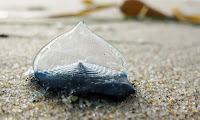Although most of my pieces were at-my-desk research articles, I occasionally got to go "on assignment," including to Humboldt County to visit a rancher, Sonoma Mission for its Indian Memorial, Mendocino County to track spotted owls.
 |
| San Miguel (see the elephant seal?) |
 |
| Durum wheat in the San Joaquin valley |
Although the magazine no longer exists, its twenty-five years are archived online, thank goodness. It's a remarkable distillation of California (mostly coastal) natural history, political shenanigans, change, and progress.
A few years ago, I compiled a list of all the stories I wrote for C&O, for posterity. Looking at it, I realize how lucky I was: I learned so much, about a huge breadth of things; I made a good friend in Rasa; and I even got paid. Here's the list:
“How Close Is Too Close? Is It OK to Attract Great White Sharks?” Winter/Spring 1995.
The effects of “chumming” for great whites off the Santa Cruz County coast.
“Santa Cruz Children Learn from the San Lorenzo.” Summer 1996.
Using the lessons of a river to gain appreciation of the environment.
“Waterfall Trail in Big Sur.” Summer 1997.
A clifftop walk at Julia Pfeiffer Burns State Park.
“Power Walk Along a Powerful Coast.” Winter 1997–98.
A personal account of the Big Sur International Marathon's 21-mile “power walk.”
“So Cold, So Rich with Life.” Summer 1998.
A friendly scientific description of oceanic upwelling.
“Elkhorn Slough Sea Otters.” Spring 1999.
The slough as a special habitat for sea otters on the California coast.
“A Delicate Balance in the Northern Channel Islands.” Autumn 1999.
A brief history of the Channel Islands off the coast of Santa Barbara, couched in a discussion of island biogeography.
“Endangered Species Chess.” Autumn 1999.
The plight of the endemic island fox of the Channel Islands.
“Wilderness Waters: California Will Create Havens for Fish Recovery.” Winter 1999–2000.
Analysis of Marine Protected Areas and their potential impact on the California coast.
“A Second Career Beneath the Tides.” Spring 2000.
An interview with octogenarian divers and underwater photographers.
Facts of kelp forest fishes. Spring 2000.
Brief profiles of a dozen or so common fish in the California kelp forest.
“The Chance to Do Science Rather Than Talk About It.” Autumn 2000.
Profile of teacher-in-the-sea Mike Guardino, sponsored by National Geographic and Sustainable Seas Expeditions.
“Howe Creek: An Experiment in Proactive Ranching.” Winter 2000–2001.
Profile of a forward-thinking rancher in Humboldt County.
“Sharing Space with Wild Animals.” Winter 2000–2001.
Finding balance between human activities and wildlife needs in public spaces.
“A California Palette.” Spring 2001.
Personal essay on spring wildflowers in the Anza-Borrego Desert.
“My First (Star)fish.” Autumn 2001.
Memoir of a childhood fishing experience.
“Mike Murray’s Highly Unusual Practice.” Winter 2001–2.
Profile of the staff veterinarian of the Monterey Bay Aquarium.
“Nature Comes to South Central L.A.” Spring 2002.
Paying a visit to a brand-new “natural park” in a downtrodden part of Los Angeles.
“Mission Indians Remembered.” Summer 2002.
A visit to the Sonoma Mission Indian Memorial, dedicated in March 1999.
"Rocks and Wrecks: Offshore Monument.” Summer 2002.
Profile of the California Coastal National Monument, established May 2002.
“Murres, Come Back to Your Rocks!” Winter 2002–3.
Elementary school children paint decoys to reestablish common murres on nesting grounds ruined by a 1986 oil spill.
“Cordell Bank.” Summer 2003.
A profile of the sixth national marine sanctuary, off San Francisco.
“The Meaning of a Foot . . . or Three?” Autumn 2003.
An examination of the potential impact of sea level rise on coastal California.
“Close Encounters of an Avian Kind.” Summer 2004.
The release of captive-bred California condors in Pinnacles National Monument.
“The Flight of the ROV.” Summer 2004.
Exploring the Channel Islands Marine Protected Areas with remotely operated vehicles.
“Bringing Kelp Forests Back to Life.” Spring/Summer 2005.
Efforts of the nonprofit organization BayKeeper to restore kelp forests in Santa Monica Bay.
“Ocean Floor Mapping.” Autumn 2005.
A history of seafloor mapping, into the present-day use of Geographic Information Systems.
“Watsonville Sloughs: Discover Nature Downtown.” Spring 2006.
A visit to a wetland area in the middle of a Central California coastal town.
“Shifting Baselines.” Vol. 22, no. 3 (2006).
A scientist’s idea of “normal” can be distorted by failure to look back in time.
“What’s Killing Sea Otters?” Vol. 22, no. 4 (2007).
Scientists examine the clues and identify the culprits.
“Treasure Hunting Along Monterey Bay.” Vol. 23, no. 2 (2007).
The fun and adventure of geocaching.
“Ants!” Vol. 23, no. 4 (2007–8).
A natural history of the Argentine ant, a recent arrival in California who is stirring up trouble.
“San Francisco Garter Snake.” Vol. 24, no. 1 (2008).
The efforts of the Golden Gate National Parks District to protect and educate people about this “most beautiful of North American snakes.”
“Into the Woods with Spotted Owls.” Vol. 24, no. 2 (2008).
A nighttime walk and talk with spotted owl biologist Mike Stephens in the redwoods of Mendocino County.
“Night Lights and Birds.” Vol. 24, no. 3 (2008).
An exploration of a little-known, but lethal in the millions, hazard for migrating birds.
“Rancho Palo Corona.” Vol. 24, no. 3 (2008).
A springtime stroll through a new parkland in Monterey County—one that fills in the missing piece to create a 70-mile-long wildlife corridor.
“Search and Rescue: A Volunteer’s First Mission.” Vol. 24, no. 4 (2008–9).
My first call-out for Monterey County Search and Rescue.
“Tracking Shark Mysteries.” Vol. 25, no. 1 (2009).
The more we learn about sharks in the wild, the more we may learn to appreciate—and protect—these ancient animals.
“Wandering the Watershed: A Road Trip.” Vol. 25, no. 2 (2009).
Exploring the San Francisco Bay watershed: the Sacramento and San Joaquin River valleys.










































